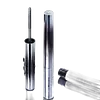What's inside
What's inside
 Key Ingredients
Key Ingredients

 Benefits
Benefits

 Concerns
Concerns

 Ingredients Side-by-side
Ingredients Side-by-side

Isododecane
EmollientTrimethylsiloxysilicate
EmollientCopernicia Cerifera Wax
Polyethylene
AbrasivePentaerythrityl Hydrogenated Rosinate
Palmitic Acid
EmollientDisteardimonium Hectorite
StabilisingSynthetic Wax
AbrasiveCI 77891
Cosmetic ColorantTalc
AbrasiveSilica
AbrasiveButylene Glycol
HumectantOlea Europaea Fruit Oil
MaskingSesamum Indicum Seed Oil
EmollientCarthamus Tinctorius Seed Oil
MaskingButyrospermum Parkii Butter
Skin ConditioningTocopherol
AntioxidantHelianthus Annuus Seed Oil
EmollientSimmondsia Chinensis Seed Oil
EmollientBHT
AntioxidantDimethicone
EmollientSqualane
EmollientSorbitan Sesquioleate
EmulsifyingHydroxyapatite
AbrasiveLecithin
EmollientHydrogenated Lecithin
EmulsifyingPropylene Carbonate
SolventPhenoxyethanol
PreservativeMica
Cosmetic ColorantZinc Oxide
Cosmetic ColorantCI 77492
Cosmetic ColorantIsododecane, Trimethylsiloxysilicate, Copernicia Cerifera Wax, Polyethylene, Pentaerythrityl Hydrogenated Rosinate, Palmitic Acid, Disteardimonium Hectorite, Synthetic Wax, CI 77891, Talc, Silica, Butylene Glycol, Olea Europaea Fruit Oil, Sesamum Indicum Seed Oil, Carthamus Tinctorius Seed Oil, Butyrospermum Parkii Butter, Tocopherol, Helianthus Annuus Seed Oil, Simmondsia Chinensis Seed Oil, BHT, Dimethicone, Squalane, Sorbitan Sesquioleate, Hydroxyapatite, Lecithin, Hydrogenated Lecithin, Propylene Carbonate, Phenoxyethanol, Mica, Zinc Oxide, CI 77492
Isododecane
EmollientTrimethylsiloxysilicate
EmollientDextrin Palmitate
EmulsifyingMicrocrystalline Wax
Emulsion StabilisingCeresin
Emulsion StabilisingPolypropylsilsesquioxane
Paraffin
PerfumingBenzalkonium Montmorillonite
EmulsifyingHydrogenated Polyisobutene
EmollientSynthetic Wax
AbrasiveRayon
CI 77491
Cosmetic ColorantCI 77499
Cosmetic ColorantCI 77007
Cosmetic ColorantPropylene Carbonate
SolventSilica
AbrasivePolymethylsilsesquioxane
Phenethyl Alcohol
MaskingCaprylic/Capric Glycerides Polyglyceryl-10 Esters
EmollientCI 77492
Cosmetic ColorantMica
Cosmetic ColorantCI 75470
Cosmetic ColorantTriethoxycaprylylsilane
CI 77266
Cosmetic ColorantPanthenol
Skin ConditioningBHT
AntioxidantIsododecane, Trimethylsiloxysilicate, Dextrin Palmitate, Microcrystalline Wax, Ceresin, Polypropylsilsesquioxane, Paraffin, Benzalkonium Montmorillonite, Hydrogenated Polyisobutene, Synthetic Wax, Rayon, CI 77491, CI 77499, CI 77007, Propylene Carbonate, Silica, Polymethylsilsesquioxane, Phenethyl Alcohol, Caprylic/Capric Glycerides Polyglyceryl-10 Esters, CI 77492, Mica, CI 75470, Triethoxycaprylylsilane, CI 77266, Panthenol, BHT
 Reviews
Reviews

Ingredients Explained
These ingredients are found in both products.
Ingredients higher up in an ingredient list are typically present in a larger amount.
BHT is a synthetic antioxidant and preservative.
As an antioxidant, it helps your body fight off free-radicals. Free-radicals are molecules that may damage your skin cells.
As a preservative, it is used to stabilize products and prevent them from degrading. Specifically, BHT prevents degradation from oxidation.
The concerns related to BHT come from oral studies; this ingredient is currently allowed for use by both the FDA and EU.
However, it was recently restricted for use in the UK as of April 2024.
Learn more about BHTCi 77492 is also hydrated iron III oxide. It's sole purpose is to give a yellow hue to products.
Iron III oxides are classified as inorganic chemicals for coloring.
Synthetically created Ci 77492 is considered safer than those naturally found. This is because the synthetically created version may contain less impurities. Iron oxides are generally non-toxic and non-allergenic.
Learn more about CI 77492Isododecane is a fragrance, emollient, and solvent.
As an emollient, it helps your skin stay soft and hydrated. Emollients help trap moisture into your skin.
Isododecane's role as a solvent makes it a great texture enhancer. It spreads smoothly on skin and does not leave a sticky feeling behind. Isododecane also helps prevent color transfer in makeup products.
Isododecane is not absorbed into skin.
Learn more about IsododecaneMica is a naturally occurring mineral used to add shimmer and color in cosmetics. It can also help improve the texture of a product or give it an opaque, white/silver color.
Serecite is the name for very fine but ragged grains of mica.
This ingredient is often coated with metal oxides like titanium dioxide. Trace amounts of heavy metals may be found in mica, but these metals are not harmful in our personal products.
Mica has been used since prehistoric times throughout the world. Ancient Egyptian, Indian, Greek, Roman, Aztec, and Chinese civilizations have used mica.
Learn more about MicaThis ingredient is a solvent. It helps dissolve active ingredients and alter the texture of products.
Propylene Carbonate is commonly used in makeup and with clay, such as montmorillonite or bentonite.
Studies show this ingredient to be safe for cosmetics. When it is undiluted, it can cause skin irritation. (It is always diluted in skincare and makeup). This ingredient is water-soluble.
Propylene Carbonate is created from propylene glycol and carbonic acid.
Learn more about Propylene CarbonateSilica, also known as silicon dioxide, is a naturally occurring mineral. It is used as a fine, spherical, and porous powder in cosmetics.
Though it has exfoliant properties, the function of silica varies depending on the product.
The unique structure of silica enhances the spreadability and adds smoothness, making it a great texture enhancer.
It is also used as an active carrier, emulsifier, and mattifier due to its ability to absorb excess oil.
In some products, tiny microneedles called spicules are made from silica or hydrolyzed sponge. When you rub them in, they lightly polish away dead skin layers and enhance the penetration of active ingredients.
Learn more about SilicaSynthetic Wax is created from fossil fuels such as natural gas. It is used to enhance texture, adjust pH, and as an occlusive.
It may also be used as an abrasive ingredient to exfoliate the skin.
Synthetic Wax may not be fungal acne safe.
Learn more about Synthetic WaxThis silicone is an emollient. Emollients create a thin film on the skin to prevent moisture from escaping.
It is not soluble in water and helps increase water-resistance in products.
According to a manufacturer, it can blend seamlessly with silicone oils, such as Cyclopentasiloxane.
Learn more about Trimethylsiloxysilicate